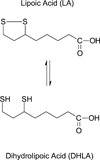Assessing the reductive capacity of cells by measuring the recycling of ascorbic and lipoic acids
- PMID: 20013182
- PMCID: PMC3724428
- DOI: 10.1007/978-1-60327-029-8_14
Assessing the reductive capacity of cells by measuring the recycling of ascorbic and lipoic acids
Abstract
Most mammalian cells cannot synthesize vitamin C, or ascorbic acid, and thus must have efficient mechanisms for its intracellular recycling. Ascorbate can be recycled from both its oxidized forms using electrons from several intracellular reducing co-factors, including GSH and the reduced pyridine nucleotides. Methods have been developed to assess the ability of intact cells to recycle ascorbate, which include assay of extracellular ferricyanide reduction and measurement of the ability of the cells to reduce dehydroascorbic acid to ascorbate. Lipoic acid, a disulfide containing medium chain fatty acid, is also taken up by cells and reduced to dihydrolipoic acid, which can be measured upon efflux from the cells using Ellman's reagent. Together, these assays provide an estimate of the ability of different cell types to recycle ascorbate and to generate intracellular reducing equivalents required to maintain the redox status of the cells.
Figures
Similar articles
-
Uptake, recycling, and antioxidant actions of alpha-lipoic acid in endothelial cells.Free Radic Biol Med. 2002 Jul 1;33(1):83-93. doi: 10.1016/s0891-5849(02)00862-6. Free Radic Biol Med. 2002. PMID: 12086686
-
Human erythrocyte recycling of ascorbic acid: relative contributions from the ascorbate free radical and dehydroascorbic acid.J Biol Chem. 2004 Apr 9;279(15):14975-82. doi: 10.1074/jbc.M312548200. Epub 2004 Jan 29. J Biol Chem. 2004. PMID: 14752116
-
Mitochondrial recycling of ascorbic acid as a mechanism for regenerating cellular ascorbate.Biofactors. 2007;30(1):35-48. doi: 10.1002/biof.5520300105. Biofactors. 2007. PMID: 18198400
-
Ascorbate function and metabolism in the human erythrocyte.Front Biosci. 1998 Jan 1;3:d1-10. doi: 10.2741/a262. Front Biosci. 1998. PMID: 9405334 Review.
-
Cellular pathways for transport and efflux of ascorbate and dehydroascorbate.Arch Biochem Biophys. 2010 Aug 15;500(2):107-15. doi: 10.1016/j.abb.2010.05.014. Epub 2010 May 28. Arch Biochem Biophys. 2010. PMID: 20494648 Review.
Cited by
-
Vitamin C - a scoping review for Nordic Nutrition Recommendations 2023.Food Nutr Res. 2023 Dec 28;67. doi: 10.29219/fnr.v67.10300. eCollection 2023. Food Nutr Res. 2023. PMID: 38187788 Free PMC article.
References
-
- Mendiratta S, Qu Z-C, May JM. Erythrocyte ascorbate recycling: Antioxidant effects in blood. Free Radic. Biol. Med. 1998;24:789–797. - PubMed
-
- Chatterjee IB, Majumder AK, Nandi BK, Subramanian N. Synthesis and some major functions of vitamin C in animals. Ann. N. Y. Acad. Sci. 1975;258:24–47. - PubMed
-
- Njus D, Kelley PM. Vitamins C and E donate single hydrogen atoms in vivo. FEBS Lett. 1991;284:147–151. - PubMed
-
- Bielski BH, Richter HW, Chan PC. Some properties of the ascorbate free radical. Ann. NY Acad. Sci. 1975;258:231–237. - PubMed
Publication types
MeSH terms
Substances
Grants and funding
LinkOut - more resources
Full Text Sources
Medical



